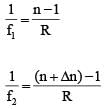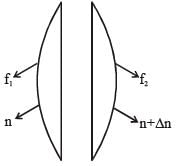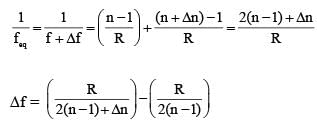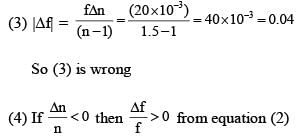JEE Exam > JEE Questions > A thin convex lens is made of two materials w...
Start Learning for Free
A thin convex lens is made of two materials with refractive indices n1 and n2, as shown in figure. The radius of curvature of the left and right spherical surfaces are equal. f is the focal length of the lens when n1 = n2 = n. The focal length is f + Δf when n1 = n and n2 = n + Δn. Assuming Δn << (n–1) and 1 < n < 2, the correct statement(s) is/are:


- a)The relation between
 remains unchanged if both the convex surfaces are replaced by concave surfaces of the same radius of curvature.
remains unchanged if both the convex surfaces are replaced by concave surfaces of the same radius of curvature. - b)

- c)For n = 1.5, Δn = 10–3 and f = 20 cm, the value of |Δf| will be 0.02 cm (round off to 2nd decimal place)
- d)

Correct answer is option 'A,C,D'. Can you explain this answer?
Verified Answer
A thin convex lens is made of two materials with refractive indices n1...
when n1 = n2 = n


 ...(1)
...(1)
2nd case:




 ...(2)
...(2)
(1) Relation between is independent of R so (1) is correct.
is independent of R so (1) is correct.
(2) 2n – 2 < n because n < 2





 ...(1)
...(1)2nd case:




 ...(2)
...(2)(1) Relation between
 is independent of R so (1) is correct.
is independent of R so (1) is correct.(2) 2n – 2 < n because n < 2




|
Explore Courses for JEE exam
|

|
Similar JEE Doubts
A thin convex lens is made of two materials with refractive indices n1 and n2, as shown in figure. The radius of curvature of the left and right spherical surfaces are equal. f is the focal length of the lens when n1 = n2 = n. The focal length is f + Δf when n1 = n and n2 = n + Δn. Assuming Δn << (n–1) and 1 < n < 2, the correct statement(s) is/are:a)The relation betweenremains unchanged if both the convex surfaces are replaced byconcave surfaces of the same radius of curvature.b)c)For n = 1.5, Δn = 10–3 and f = 20 cm, the value of |Δf| will be 0.02 cm (round off to 2nd decimal place)d)Correct answer is option 'A,C,D'. Can you explain this answer?
Question Description
A thin convex lens is made of two materials with refractive indices n1 and n2, as shown in figure. The radius of curvature of the left and right spherical surfaces are equal. f is the focal length of the lens when n1 = n2 = n. The focal length is f + Δf when n1 = n and n2 = n + Δn. Assuming Δn << (n–1) and 1 < n < 2, the correct statement(s) is/are:a)The relation betweenremains unchanged if both the convex surfaces are replaced byconcave surfaces of the same radius of curvature.b)c)For n = 1.5, Δn = 10–3 and f = 20 cm, the value of |Δf| will be 0.02 cm (round off to 2nd decimal place)d)Correct answer is option 'A,C,D'. Can you explain this answer? for JEE 2025 is part of JEE preparation. The Question and answers have been prepared according to the JEE exam syllabus. Information about A thin convex lens is made of two materials with refractive indices n1 and n2, as shown in figure. The radius of curvature of the left and right spherical surfaces are equal. f is the focal length of the lens when n1 = n2 = n. The focal length is f + Δf when n1 = n and n2 = n + Δn. Assuming Δn << (n–1) and 1 < n < 2, the correct statement(s) is/are:a)The relation betweenremains unchanged if both the convex surfaces are replaced byconcave surfaces of the same radius of curvature.b)c)For n = 1.5, Δn = 10–3 and f = 20 cm, the value of |Δf| will be 0.02 cm (round off to 2nd decimal place)d)Correct answer is option 'A,C,D'. Can you explain this answer? covers all topics & solutions for JEE 2025 Exam. Find important definitions, questions, meanings, examples, exercises and tests below for A thin convex lens is made of two materials with refractive indices n1 and n2, as shown in figure. The radius of curvature of the left and right spherical surfaces are equal. f is the focal length of the lens when n1 = n2 = n. The focal length is f + Δf when n1 = n and n2 = n + Δn. Assuming Δn << (n–1) and 1 < n < 2, the correct statement(s) is/are:a)The relation betweenremains unchanged if both the convex surfaces are replaced byconcave surfaces of the same radius of curvature.b)c)For n = 1.5, Δn = 10–3 and f = 20 cm, the value of |Δf| will be 0.02 cm (round off to 2nd decimal place)d)Correct answer is option 'A,C,D'. Can you explain this answer?.
A thin convex lens is made of two materials with refractive indices n1 and n2, as shown in figure. The radius of curvature of the left and right spherical surfaces are equal. f is the focal length of the lens when n1 = n2 = n. The focal length is f + Δf when n1 = n and n2 = n + Δn. Assuming Δn << (n–1) and 1 < n < 2, the correct statement(s) is/are:a)The relation betweenremains unchanged if both the convex surfaces are replaced byconcave surfaces of the same radius of curvature.b)c)For n = 1.5, Δn = 10–3 and f = 20 cm, the value of |Δf| will be 0.02 cm (round off to 2nd decimal place)d)Correct answer is option 'A,C,D'. Can you explain this answer? for JEE 2025 is part of JEE preparation. The Question and answers have been prepared according to the JEE exam syllabus. Information about A thin convex lens is made of two materials with refractive indices n1 and n2, as shown in figure. The radius of curvature of the left and right spherical surfaces are equal. f is the focal length of the lens when n1 = n2 = n. The focal length is f + Δf when n1 = n and n2 = n + Δn. Assuming Δn << (n–1) and 1 < n < 2, the correct statement(s) is/are:a)The relation betweenremains unchanged if both the convex surfaces are replaced byconcave surfaces of the same radius of curvature.b)c)For n = 1.5, Δn = 10–3 and f = 20 cm, the value of |Δf| will be 0.02 cm (round off to 2nd decimal place)d)Correct answer is option 'A,C,D'. Can you explain this answer? covers all topics & solutions for JEE 2025 Exam. Find important definitions, questions, meanings, examples, exercises and tests below for A thin convex lens is made of two materials with refractive indices n1 and n2, as shown in figure. The radius of curvature of the left and right spherical surfaces are equal. f is the focal length of the lens when n1 = n2 = n. The focal length is f + Δf when n1 = n and n2 = n + Δn. Assuming Δn << (n–1) and 1 < n < 2, the correct statement(s) is/are:a)The relation betweenremains unchanged if both the convex surfaces are replaced byconcave surfaces of the same radius of curvature.b)c)For n = 1.5, Δn = 10–3 and f = 20 cm, the value of |Δf| will be 0.02 cm (round off to 2nd decimal place)d)Correct answer is option 'A,C,D'. Can you explain this answer?.
Solutions for A thin convex lens is made of two materials with refractive indices n1 and n2, as shown in figure. The radius of curvature of the left and right spherical surfaces are equal. f is the focal length of the lens when n1 = n2 = n. The focal length is f + Δf when n1 = n and n2 = n + Δn. Assuming Δn << (n–1) and 1 < n < 2, the correct statement(s) is/are:a)The relation betweenremains unchanged if both the convex surfaces are replaced byconcave surfaces of the same radius of curvature.b)c)For n = 1.5, Δn = 10–3 and f = 20 cm, the value of |Δf| will be 0.02 cm (round off to 2nd decimal place)d)Correct answer is option 'A,C,D'. Can you explain this answer? in English & in Hindi are available as part of our courses for JEE.
Download more important topics, notes, lectures and mock test series for JEE Exam by signing up for free.
Here you can find the meaning of A thin convex lens is made of two materials with refractive indices n1 and n2, as shown in figure. The radius of curvature of the left and right spherical surfaces are equal. f is the focal length of the lens when n1 = n2 = n. The focal length is f + Δf when n1 = n and n2 = n + Δn. Assuming Δn << (n–1) and 1 < n < 2, the correct statement(s) is/are:a)The relation betweenremains unchanged if both the convex surfaces are replaced byconcave surfaces of the same radius of curvature.b)c)For n = 1.5, Δn = 10–3 and f = 20 cm, the value of |Δf| will be 0.02 cm (round off to 2nd decimal place)d)Correct answer is option 'A,C,D'. Can you explain this answer? defined & explained in the simplest way possible. Besides giving the explanation of
A thin convex lens is made of two materials with refractive indices n1 and n2, as shown in figure. The radius of curvature of the left and right spherical surfaces are equal. f is the focal length of the lens when n1 = n2 = n. The focal length is f + Δf when n1 = n and n2 = n + Δn. Assuming Δn << (n–1) and 1 < n < 2, the correct statement(s) is/are:a)The relation betweenremains unchanged if both the convex surfaces are replaced byconcave surfaces of the same radius of curvature.b)c)For n = 1.5, Δn = 10–3 and f = 20 cm, the value of |Δf| will be 0.02 cm (round off to 2nd decimal place)d)Correct answer is option 'A,C,D'. Can you explain this answer?, a detailed solution for A thin convex lens is made of two materials with refractive indices n1 and n2, as shown in figure. The radius of curvature of the left and right spherical surfaces are equal. f is the focal length of the lens when n1 = n2 = n. The focal length is f + Δf when n1 = n and n2 = n + Δn. Assuming Δn << (n–1) and 1 < n < 2, the correct statement(s) is/are:a)The relation betweenremains unchanged if both the convex surfaces are replaced byconcave surfaces of the same radius of curvature.b)c)For n = 1.5, Δn = 10–3 and f = 20 cm, the value of |Δf| will be 0.02 cm (round off to 2nd decimal place)d)Correct answer is option 'A,C,D'. Can you explain this answer? has been provided alongside types of A thin convex lens is made of two materials with refractive indices n1 and n2, as shown in figure. The radius of curvature of the left and right spherical surfaces are equal. f is the focal length of the lens when n1 = n2 = n. The focal length is f + Δf when n1 = n and n2 = n + Δn. Assuming Δn << (n–1) and 1 < n < 2, the correct statement(s) is/are:a)The relation betweenremains unchanged if both the convex surfaces are replaced byconcave surfaces of the same radius of curvature.b)c)For n = 1.5, Δn = 10–3 and f = 20 cm, the value of |Δf| will be 0.02 cm (round off to 2nd decimal place)d)Correct answer is option 'A,C,D'. Can you explain this answer? theory, EduRev gives you an
ample number of questions to practice A thin convex lens is made of two materials with refractive indices n1 and n2, as shown in figure. The radius of curvature of the left and right spherical surfaces are equal. f is the focal length of the lens when n1 = n2 = n. The focal length is f + Δf when n1 = n and n2 = n + Δn. Assuming Δn << (n–1) and 1 < n < 2, the correct statement(s) is/are:a)The relation betweenremains unchanged if both the convex surfaces are replaced byconcave surfaces of the same radius of curvature.b)c)For n = 1.5, Δn = 10–3 and f = 20 cm, the value of |Δf| will be 0.02 cm (round off to 2nd decimal place)d)Correct answer is option 'A,C,D'. Can you explain this answer? tests, examples and also practice JEE tests.

|
Explore Courses for JEE exam
|

|
Signup for Free!
Signup to see your scores go up within 7 days! Learn & Practice with 1000+ FREE Notes, Videos & Tests.


























